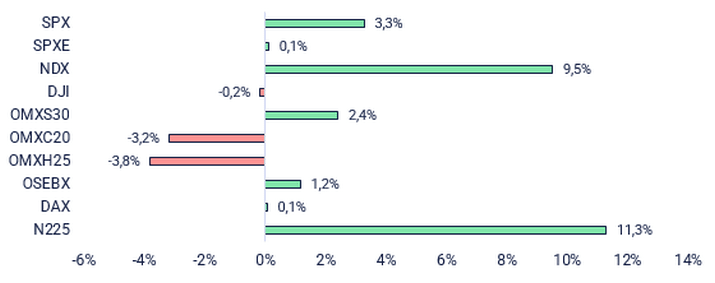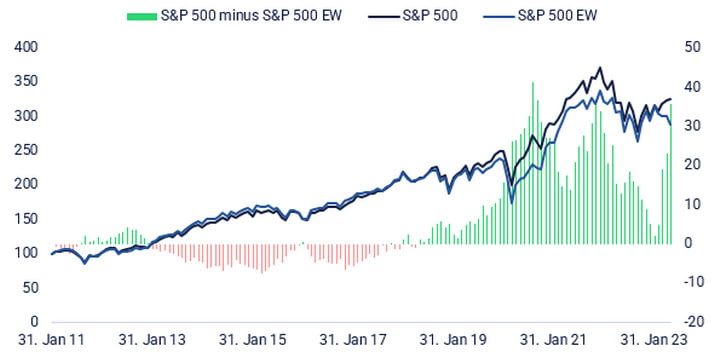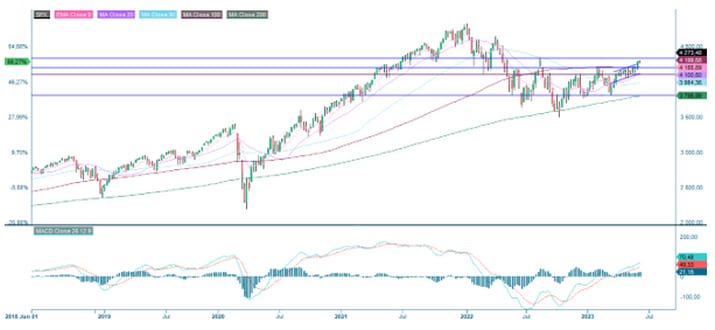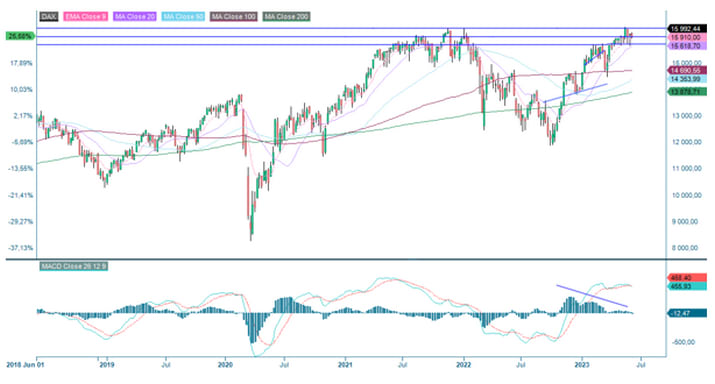Time to catch up on tech

It took the market some time to digest the ever-so-important US job figures that gave us mixed signals. Meanwhile, the spread between S & P 500 and the equally weighted S & P 500 implies that the tech sector may have done its job. On soft commodities, Soybeans were so 2020 to 2022.
Case of the week: Chinese customs control boosts soybean stocks
Global soybean prices have significantly declined in recent months, falling well below the average levels observed in the past two years. At the moment, we observe an imbalance between the demand and supply. The leading exporters, Brazil and USA, anticipate growing demand, while Chinese imports have experienced a slowdown following stricter import control and more extensive stocks of domestically produced soybeans.
According to the US Department of Agriculture (USDA), Brazil's soybean harvest 2023 is estimated at 155 million tonnes, surpassing the previous record by 11%. The corresponding number in the US is approximately 122.7 tonnes, while Argentina, the third largest exporter, is expected to produce average yields in 2023 (about 44 million tonnes).
The robust harvests expected in the three major soybean exporting countries in 2023-24 could result in a nearly 11% increase in global production compared to the current year, marking the most significant annual gain in seven years.
China, the largest importer of soybeans, typically imports between 95 million and 97 million tonnes of soybeans annually, with the majority sourced from Brazil and the United States. Approximately 80% of these imported soybeans produce protein-rich soybean meal, which serves as animal feed, predominantly for China's extensive pork sector. Lately, Chinese customs have toughened quality inspection norms for imported soybeans, with the average duration for vessel inspections surpassing 20 days compared to the usual timeframe of 3-4 days. Combined with the large production numbers in Brazil, USA, and Argentina, we could see a potential build-up of stored soybeans following the Chinese customs delay. Furthermore, the inventory of domestically produced soybeans has increased in China. The stricter import inspection regulations will compel farmers to purchase locally sourced soybeans instead of imported soybeans once their existing stock is depleted, fueling a further possible decline in soybean prices.
Soybean future (CBT$/Bushel), daily one-year price chart

Soybean future (CBT$/Bushel), weekly five-year price chart

General market comments: US job figures are digested by the market, and its good news for stocks
Last week, eyes were set on China's Purchasing Managers' Index (PMI), European inflation, the US debt ceiling and, of course, the US labour market. Nikkei and Nasdaq 100 are the winners, while OMXC20 and OMXH25 have lagged since May 8th 2023. See the chart below where SPXE represent S&P 500 Equal weights.
Persentage development since 08 May, 2023

China's PMI came in at a five-month low, weaker than expected, increasing the uncertainty on the strength of the country’s recovery. The PMI figures sent HSI down, but the index more than recovered nicely on Friday. However, currently, the index seems to be having difficulties breaking the falling trend.
European inflation came in on the soft side. Food prices increased slightly with some exceptions in the details. E.g., in Germany, food prices fell for the second consecutive month. The softening inflation tightens the room for further rate hikes by the ECB. Nevertheless, German 2-year yield is up this week.
The news on the US House of Representatives and the Senate that passed the deal on increasing the debt ceiling was challenging to avoid. However, this was largely already discounted in the market, as no significant rally could be associated with the event.
On Friday, the critical US job figures showed a strong job creation in May of 339k, compared to the expected 180k. Wages increased by 4.3%, in line with expectations. That all support the Fed to continue hiking rates. However, on the other side, the unemployment rate landed at 3.7%, higher than expected at 3.5%. Also, the monthly hourly wage increased sequentially by 0.3%, below expectations of 0.4%.
The initial move on the US markets was also contrary as stocks and interest rates rose. During the beginning of this week, as the job figures have been digested, the probability of a Fed rate hike in June has come down to the current 24%, down from 67% on May 30th. Stocks are up so far this week, while rates are coming down. A soft reading for the ISM service on Monday at 54.9, versus the expected 55.1, may have contributed a tiny notch.
What’s next this week
The macro agenda for the remaining day of the week is relatively thin. Today, OECD will release a new Economic Outlook. In the US, we have Initial jobless claims on Thursday, while Norwegian Consumer Price Index (CPI) is due on Friday, 9 June. Next week will be busier with CPI from the US on Tuesday and the eurozone on Friday.
Time for a catch up on tech
Over the last 30 days, Nasdaq (along with Nikkei) has been the clear winner. The broader S&P 500 is up 3.3% thanks to the heavily weighted tech giants. Worth noticing is that the spread between S&P 500 and equally weighted S&P 500 (S&P 500 EW) is getting close to levels where it bounced back before. See the chart below. It may be time for the rest of the market to catch up. In such a scenario, S&P 500 may outperform Nasdaq.
Stock market development since 31 Dec, 2010. Index = 100

Resistance in S&P 500 is getting closer while Nasdaq is overbought
S&P 500 broke up above the ceiling of a short rising trend channel. The previous high from August 2022, around 4,300, remains the first resistance level.
S&P500 price chart (in USD), one-year daily chart

S&P500 price chart (in USD), five-year weekly chart

Nasdaq 100 has been trading more or less sideways during the first two days of this week. In the case of regained strength, the next level is around 15,200. Note that the index may be at overbought levels.
Nasdaq 100 (in USD), one-year daily chart

Nasdaq 100 (in USD), weekly five-year chart

OMXS30 is trading close to the ceiling of a slightly rising trend channel. Note that Monday’s trading ended with a scary-looking doji. The negative divergence between the index and MACD remains.
OMXS30 (in SEK), two-year daily chart

With some effort, a bullish flag-like formation can be spotted in the weekly chart.
OMXS30 (in SEK), weekly five-year chart

The German DAX also struggles to find direction under negative divergence with MACD.
DAX (in EUR), two-year daily chart

Note that MACD has generated a soft sell signal in the weekly chart.
DAX (in EUR), weekly five-year chart

The SEK is in trouble. The chart below shows that the resistance of around 10.85 versus the USD has been broken. Is 11,2 next? Nevertheless, such a scenario would serve OMXS30 well.
USD/SEK, one-year daily graph

The instruments below have the underlying USD per 1 SEK.
EUR/SEK, five-year weekly graph

The full name for abbreviations used in the previous text:
EMA 9: 9-day exponential moving average
Fibonacci: There are several Fibonacci lines used in technical analysis. Fibonacci numbers are a sequence of numbers in which each successive number is the sum of the two previous numbers.
MA20: 20-day moving average
MA50: 50-day moving average
MA100: 100-day moving average
MA200: 200-day moving average
MACD: Moving average convergence divergence
Risiko
Ekstern forfatter:
Denne informasjonen er utelukkende på gjesteforfatterens ansvar og representerer ikke nødvendigvis oppfatningen til Bank Vontobel Europe AG eller noe annet selskap i Vontobel Group. Den videre utviklingen av indeksen eller et selskap samt aksjekursen avhenger av en lang rekke selskaps-, gruppe- og sektorspesifikke samt økonomiske faktorer. Hver investor må ta hensyn til risikoen for kurstap i investeringsbeslutningen. Vær oppmerksom på at investering i disse produktene ikke vil generere løpende inntekter.
Produktene er ikke kapitalbeskyttet, i verste fall er et totalt tap av investert kapital mulig. Ved insolvens av utstederen og garantisten, bærer investoren risikoen for totaltap av sin investering. I alle fall bør investorer merke seg at tidligere resultater og/eller analytikeres meninger ikke er en tilstrekkelig indikator på fremtidig ytelse. Ytelsen til de underliggende elementene avhenger av en rekke økonomiske, entreprenørielle og politiske faktorer som bør tas i betraktning i dannelsen av en markedsforventning.
Disclaimer:
Denne informasjonen er verken et investeringsråd eller en investerings- eller investeringsstrategianbefaling, men en annonse. Den fullstendige informasjonen om handelsproduktene (verdipapirene) nevnt her, spesielt strukturen og risikoene knyttet til en investering, er beskrevet i basisprospektet, sammen med eventuelle tillegg, samt de endelige vilkårene. Grunnprospektet og de endelige vilkårene utgjør de eneste bindende salgsdokumentene for verdipapirene og er tilgjengelige under produktlenkene. Det anbefales at potensielle investorer leser disse dokumentene før de tar noen investeringsbeslutning. Dokumentene og nøkkelinformasjonsdokumentet er publisert på nettsiden til utstederen, Vontobel Financial Products GmbH, Bockenheimer Landstrasse 24, 60323 Frankfurt am Main, Tyskland, på prospectus.vontobel.com og er gratis tilgjengelig fra utstederen. Godkjenningen av prospektet skal ikke forstås som en godkjenning av verdipapirene. Verdipapirene er produkter som ikke er enkle og kan være vanskelige å forstå. Denne informasjonen inkluderer eller er relatert til tall for tidligere resultater. Tidligere resultater er ikke en pålitelig indikator på fremtidig ytelse.
